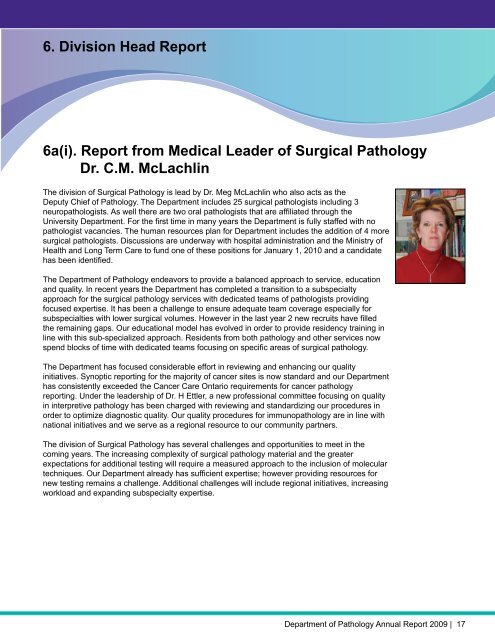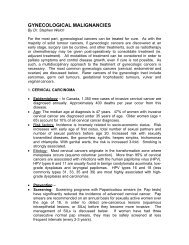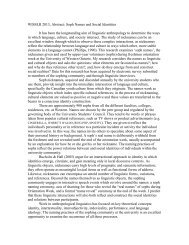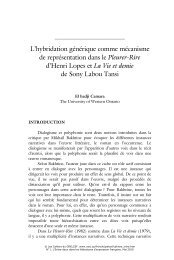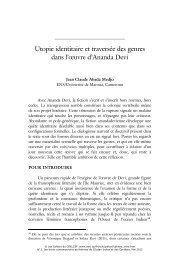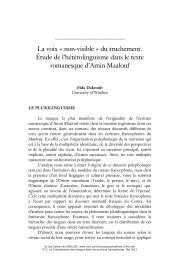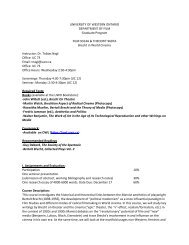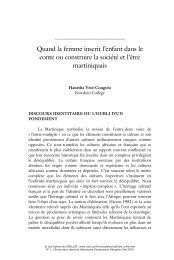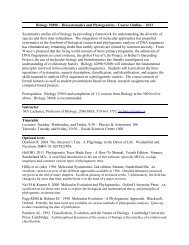Department of Pathology ANNUAL REPORT 2009 - University of ...
Department of Pathology ANNUAL REPORT 2009 - University of ...
Department of Pathology ANNUAL REPORT 2009 - University of ...
Create successful ePaper yourself
Turn your PDF publications into a flip-book with our unique Google optimized e-Paper software.
6. Division Head Report<br />
6a(i). Report from Medical Leader <strong>of</strong> Surgical <strong>Pathology</strong><br />
Dr. C.M. McLachlin<br />
The division <strong>of</strong> Surgical <strong>Pathology</strong> is lead by Dr. Meg McLachlin who also acts as the<br />
Deputy Chief <strong>of</strong> <strong>Pathology</strong>. The <strong>Department</strong> includes 25 surgical pathologists including 3<br />
neuropathologists. As well there are two oral pathologists that are affiliated through the<br />
<strong>University</strong> <strong>Department</strong>. For the first time in many years the <strong>Department</strong> is fully staffed with no<br />
pathologist vacancies. The human resources plan for <strong>Department</strong> includes the addition <strong>of</strong> 4 more<br />
surgical pathologists. Discussions are underway with hospital administration and the Ministry <strong>of</strong><br />
Health and Long Term Care to fund one <strong>of</strong> these positions for January 1, 2010 and a candidate<br />
has been identified.<br />
The <strong>Department</strong> <strong>of</strong> <strong>Pathology</strong> endeavors to provide a balanced approach to service, education<br />
and quality. In recent years the <strong>Department</strong> has completed a transition to a subspecialty<br />
approach for the surgical pathology services with dedicated teams <strong>of</strong> pathologists providing<br />
focused expertise. It has been a challenge to ensure adequate team coverage especially for<br />
subspecialties with lower surgical volumes. However in the last year 2 new recruits have filled<br />
the remaining gaps. Our educational model has evolved in order to provide residency training in<br />
line with this sub-specialized approach. Residents from both pathology and other services now<br />
spend blocks <strong>of</strong> time with dedicated teams focusing on specific areas <strong>of</strong> surgical pathology.<br />
The <strong>Department</strong> has focused considerable effort in reviewing and enhancing our quality<br />
initiatives. Synoptic reporting for the majority <strong>of</strong> cancer sites is now standard and our <strong>Department</strong><br />
has consistently exceeded the Cancer Care Ontario requirements for cancer pathology<br />
reporting. Under the leadership <strong>of</strong> Dr. H Ettler, a new pr<strong>of</strong>essional committee focusing on quality<br />
in interpretive pathology has been charged with reviewing and standardizing our procedures in<br />
order to optimize diagnostic quality. Our quality procedures for immunopathology are in line with<br />
national initiatives and we serve as a regional resource to our community partners.<br />
The division <strong>of</strong> Surgical <strong>Pathology</strong> has several challenges and opportunities to meet in the<br />
coming years. The increasing complexity <strong>of</strong> surgical pathology material and the greater<br />
expectations for additional testing will require a measured approach to the inclusion <strong>of</strong> molecular<br />
techniques. Our <strong>Department</strong> already has sufficient expertise; however providing resources for<br />
new testing remains a challenge. Additional challenges will include regional initiatives, increasing<br />
workload and expanding subspecialty expertise.<br />
<strong>Department</strong> <strong>of</strong> <strong>Pathology</strong> Annual Report <strong>2009</strong> | 17


